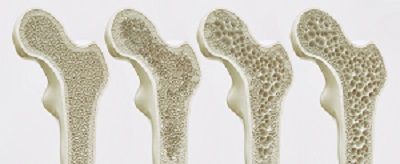 The bone is a living tissue, which is in a perpetual renewal process. The body permanently destroys (resorption) and rebuilds the bone tissue. This renweal process of the bone matter tends to slow down with aging. Specialized cells called osteoclasts carry out the resorption process. They release calcium from the bone into the blood stream. By opposition, the osteoblasts are responsible for the synthesis of bone tissue (regeneration), which is accomplished from the minerals (calcium and phosphorus) present in the blood and used as building material. The balance between those two activities is controlled by hormones (parathormone and calcitonin) the renal functions and by the vitamin D.
The bone is a living tissue, which is in a perpetual renewal process. The body permanently destroys (resorption) and rebuilds the bone tissue. This renweal process of the bone matter tends to slow down with aging. Specialized cells called osteoclasts carry out the resorption process. They release calcium from the bone into the blood stream. By opposition, the osteoblasts are responsible for the synthesis of bone tissue (regeneration), which is accomplished from the minerals (calcium and phosphorus) present in the blood and used as building material. The balance between those two activities is controlled by hormones (parathormone and calcitonin) the renal functions and by the vitamin D.
At an older age, the rate of bone resorption exceeds the regeneration rate. That situation can develop into osteoporosis, whose consequences go from the weakening of the bones to collapsing vertebrae and a propensity to fractures (wrist and neck of the femur).
Causes and types of osteoporosis
Certain forms of osteoporosis are localised and consecutive to a traumatism (for example a blow or a fracture to the hand or foot). In most cases however, the disease is generalized (primary osteoporosis) and concerns the skeleton as a whole while affecting some bones in particular more than others.
- Type I Osteoporosis: The most frequent form of the disease, consecutive to the menopause, it concerns the women suffering from oestrogens deficiency. Moreover, a nutritional deficiency of calcium, lack of physical exercise, a history of osteoporosis cases in the family could all constitute supporting factors of its occurrence.
- Type II Osteoporosis: The senile osteoporosis generally concerns male subjects aged over 70 years old.
- Idiopathic osteoporosis: Is a rare condition of unknown origin that affects premonopausal women and middle-aged or even younger men.
- Other forms of secondary osteoporosis: They find their origin in another disease or in particular circumstances: prolonged confinement to bed (bone disuse), nutritional and/or endocrine disorders (including anorexia nervosa), drug treatments such as steroids, corticoid, Warfarin or Heparin sodium (anticoagulants Coumadin – Calciparine).
Symptoms and detection
Osteoporosis is often asymptomatic for years. Over time, one perceives that s/he is not as tall as before; this is often ascribable in particular to the deformation of the spinal column. Also over time, one becomes prone to fractures, unbeknownst to one self, those frequently happen to the vertebrae of the lower spine (collapsing vertebrae), to the neck of the femur and also to the wrist or the head of the humerus. The test of bone densitometry by radiography (DEXA Scan) remains the detection method of reference.
Action of Osteoparine
OsteoParine is composed of specific plants and natural substances that inhibit the bone resorption function (destruction of the bone tissue), whereas some other plants constitute a calcium contribution, which will be used for regeneration of the bones. Also, some plants facilitate the absorption of OsteoParine and calcium by the organism.




